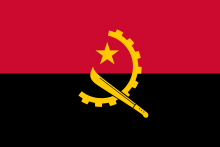People's Armed Forces of Liberation of Angola
| People's Armed Forces of Liberation of Angola Forças Armadas de Libertação de Angola |
|
|---|---|

|
|
| Founded | 1974 |
| Disbanded | 1993 |
| Service branches |
People's Army for the Liberation of Angola (EPLA) Angolan Navy People's Air Force of Angola / Anti-Aircraft Defense (FAPA/DAA) |
| Leadership | |
| President of Angola, Commander-in-Chief | José Eduardo dos Santos |
| Industry | |
| Foreign suppliers | Soviet Union |
| Related articles | |
| History |
Angolan War of Independence South African Border War Angolan Civil War |
|
|
The People's Armed Forces of Liberation of Angola (Portuguese: Forças Armadas Populares de Libertação de Angola) or FAPLA was originally the armed wing of the People's Movement for the Liberation of Angola (MPLA) but later (1975–1991) became Angola's official armed forces when the MPLA took control of the government.
After the Bicesse Accords in 1993, the FAPLA were transformed in the Angolan Armed Forces (Forças Armadas de Angola) or FAA, by the integration of the members of the Armed Forces of Liberation of Angola or FALA, which constituted the former armed wing of UNITA.
In the early 1960s the MPLA named its guerrilla forces the "People's Army for the Liberation of Angola" (Exército Popular de Libertação de Angola - EPLA). Many of its first cadres had received training in Morocco and Algeria. In January 1963, in one of its early operations, the EPLA attacked a Portuguese military post in Cabinda, killing a number of troops. During the mid-1960s and early 1970s, the EPLA operated very successfully from bases in Zambia against the Portuguese in eastern Angola. After 1972, however, the EPLA's effectiveness declined following several Portuguese victories, disputes with National Liberation Front of Angola (FNLA) forces, and the movement of about 800 guerrillas from Zambia to the Republic of Congo.
On August 1, 1974 a few months after a military coup d'état had overthrown the Lisbon regime and proclaimed its intention of granting independence to Angola, the MPLA announced the formation of FAPLA, which replaced the EPLA. James writes that in 1974-75, '..after a period of six months, Moscow started to arm Neto's faction exclusively. The Soviet Union supplied the MPLA with $300 million worth of materiel as compared to $54 million over the previous fourteen years. The weapons that went to MPLA included AK-47 assault rifles, 120-mm mortars, 82-mm and 107-mm recoilless rifles, 37-mm and 14.5 mm antiaircraft guns..' and T-34, T-54, and PT-76 tanks. Independence was set for November 11, 1975.
...
Wikipedia
